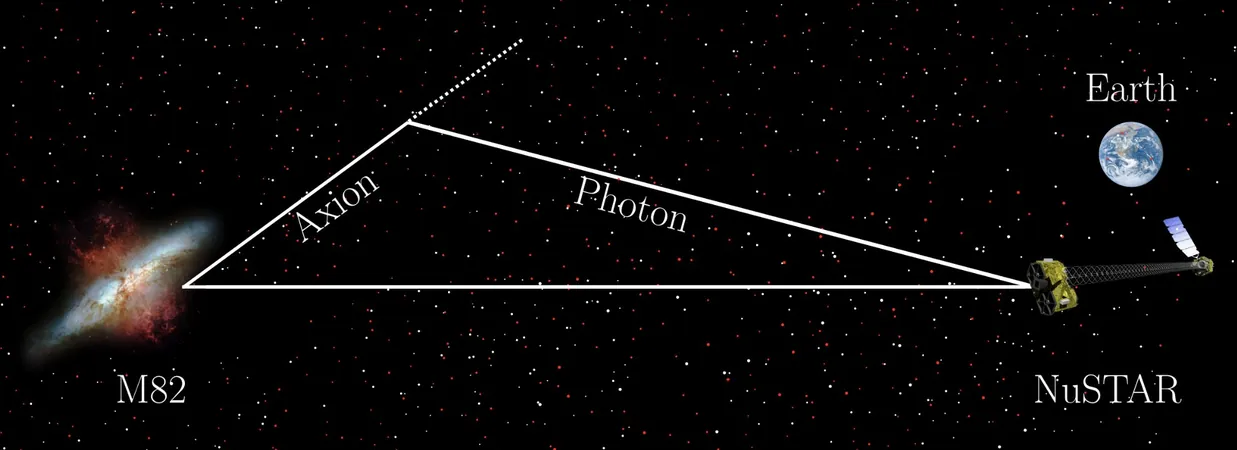
Unlocking the Secrets of Dark Matter: The Hunt for Axions via X-Ray Analysis of Galaxies
2025-06-09
Author: Nur
The Elusive Quest for Dark Matter
The journey to unravel the mystery of dark matter—an enigmatic substance that is believed to make up the majority of the universe's mass—continues to intrigue scientists. While countless experiments are underway, conclusive evidence remains elusive. Enter axions, hypothetical elementary particles first proposed in the 1970s, which stand out as leading candidates for this hidden form of matter.
Independent Research Unlocks New Avenues
Recently, two pioneering research teams, one from the Università di Padova and its international collaborators, and the other from UC Berkeley, set out on independent quests to detect axions through X-ray observations of galaxies using the Nuclear Spectroscopic Telescope Array (NuSTAR). Both teams published their findings in Physical Review Letters, revealing stricter constraints on axion properties while opening exciting new possibilities for future searches.
What Makes Axions So Special?
Edoardo Vitagliano, co-author of one of the studies, stressed the significance of recent null results from other large experiments, suggesting that the field is ready to explore less conventional particles like axions. "They offer a fascinating potential for physics beyond the Standard Model," he noted, as these particles could solve lingering puzzles in particle physics.
X-Ray Imaging: A Powerful Tool
The research proposes a groundbreaking method for detecting axions by analyzing their faint interactions with photons—light particles. Stars produce vast numbers of such photons, which can facilitate the generation of axions through weak interactions. The team focused on starburst galaxies, like M82 (The Cigar Galaxy), where massive stars create ideal conditions for axion production.
Tracing Axions Through Stellar Explosions
As Vitagliano explained, the intense conditions in stellar interiors can initiate axion production with energies around 100 keV, emitting photons analogous to those used in medical imaging. The resulting X-ray signals in starburst galaxies could dramatically differ from typical emissions, offering a tantalizing signal to chase.
Mapping the Halo of Axions
The researchers modeled these X-ray halos surrounding galaxies, predicting that they would emerge from axions decaying into photons. Analyzing over 1 million seconds of data from NuSTAR, they found no signs of these expected signals, but this allowed them to refine their understanding and establish critical constraints on how axions interact with photons.
Exploring New Frontiers of Axion Physics
Despite their searches yielding no direct evidence of axions, these studies expanded the parameter space for axions with masses under MeV, turning M82 into a dynamic laboratory for potential discoveries. Findings could also illuminate insights into the early universe's conditions.
Collaborations Drive Progress
Coinciding with this work, a second team from UC Berkeley delved into similar territories, leveraging galaxies’ vast populations to maximize potential axion signals. Co-author Orion Ning detailed their approach, which hinged on predicting axion production within stellar interiors and observing their eventual transformations back into photons. This collaborative endeavor strengthens the case for examining entire stellar populations in the quest to uncover dark matter.
Future Directions in Dark Matter Research
Plans are already underway for both teams to push the envelope even further. Future studies will explore how axions might interact with electrons and protons, delving into various astrophysical scenarios. These researchers are determined to continue exploring multiple avenues until they uncover, or definitively rule out, the existence of axions.
Stay Tuned: The Search for Axions Continues!
As these groundbreaking studies progress, excitement among physicists will undoubtedly grow. The ongoing search for axions not only seeks to solve the mystery of dark matter but also has the potential to reshape our understanding of the universe. With the cosmos as their laboratory, researchers are primed for future discoveries that could rewrite the laws of physics as we know them.




 Brasil (PT)
Brasil (PT)
 Canada (EN)
Canada (EN)
 Chile (ES)
Chile (ES)
 Česko (CS)
Česko (CS)
 대한민국 (KO)
대한민국 (KO)
 España (ES)
España (ES)
 France (FR)
France (FR)
 Hong Kong (EN)
Hong Kong (EN)
 Italia (IT)
Italia (IT)
 日本 (JA)
日本 (JA)
 Magyarország (HU)
Magyarország (HU)
 Norge (NO)
Norge (NO)
 Polska (PL)
Polska (PL)
 Schweiz (DE)
Schweiz (DE)
 Singapore (EN)
Singapore (EN)
 Sverige (SV)
Sverige (SV)
 Suomi (FI)
Suomi (FI)
 Türkiye (TR)
Türkiye (TR)
 الإمارات العربية المتحدة (AR)
الإمارات العربية المتحدة (AR)